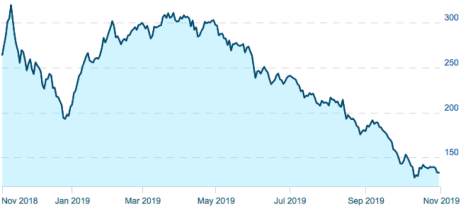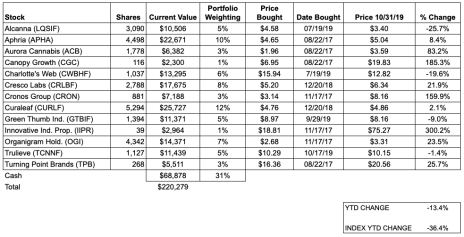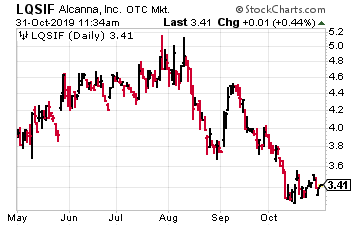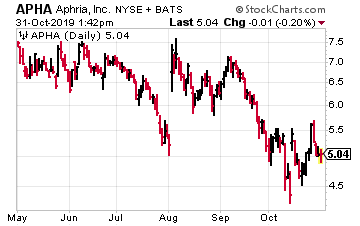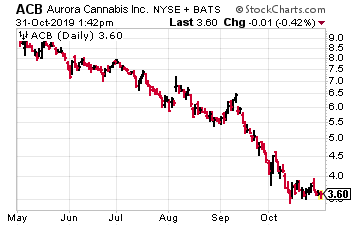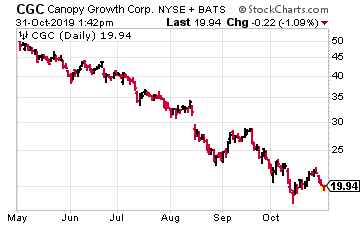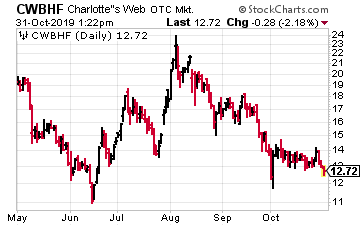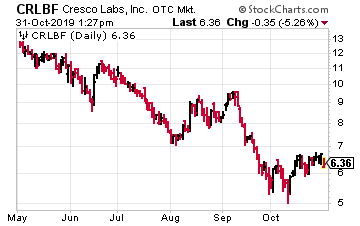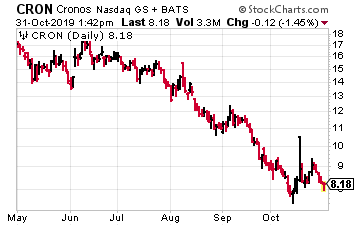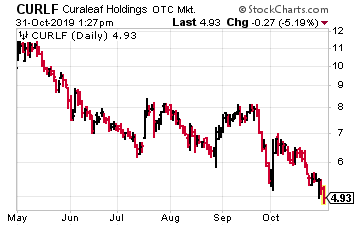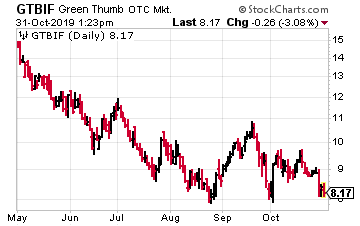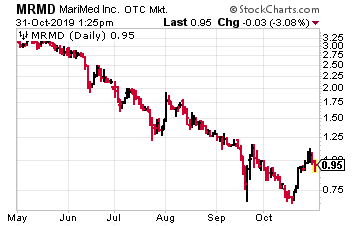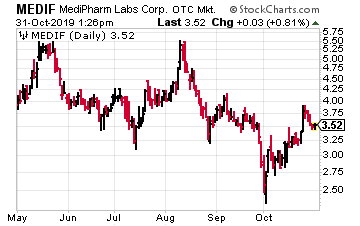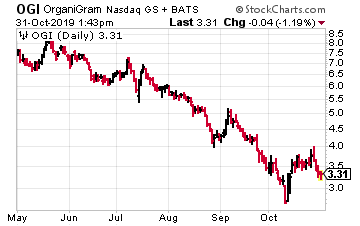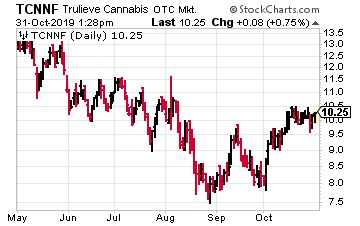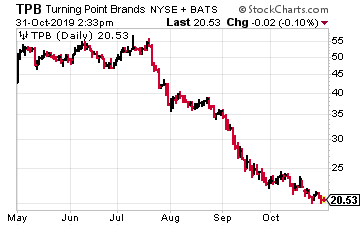One year ago, soon after marijuana sales became legal in Canada, investors were throwing money at the sector, anxious to get a piece of the action. Today, the opposite is true—getting money for a cannabis business takes real work!
Cabot Marijuana Investor 1019
Be Not Afraid
One year ago, soon after marijuana sales became legal in Canada, investors were throwing money at the sector, anxious to get a piece of the action. Today, the opposite is true—getting money for a cannabis business takes real work!
That was my key takeaway from the Benzinga Cannabis Capital Conference, which I attended last week in Chicago and where executives from dozens of companies, both public and private, pitched their companies to the crowd. In addition to marketing themselves, some of these companies are scrambling to conserve cash, while others are revising terms (downward) for deals signed when the sector is hot.
And that’s not surprising given the action of the stocks. Since peaking in March, the average U.S. cannabis stock is down 56%, while the average Canadian cannabis stock is down 64%. Investors have been running from these stocks like kids running from a haunted house! (It’s Halloween here in Salem.)
Happily, some of the stocks have already bottomed—generally stocks that were not previously popular. But some are still under pressure and may not feel relief until year-end tax selling has run its course. But that’s my most pessimistic expectation. Fact is, the industry remains full of explosive growth; after today’s portfolio changes, the average company in our portfolio will have seen revenues grow 322% in the latest quarter. So while recent months have been challenging, there’s no question that the long-term prospects remain very bright for investors in the sector.
News
Two weeks ago, it became legal for Canadians to deal in cannabis edibles and beverages and vapes, though because the government built in a period to enable “stocking,” no real sales will occur until mid-December. When sales of edibles and vapes and beverages actually begin, the early results will be very interesting.
The U.S. government remains far behind in providing guidelines for CBD (cannabidiol) use—the effect of 49 years of prohibition. Essentially, there is none.
In the meantime, growing numbers of companies are investigating the production and testing of cannabigerol (CBG), one of the more than 120 cannabinoids found in cannabis. But if we don’t know enough about CBD, we know even less about CBG. Possibilities are that it could be effective in treating blood pressure, pain, inflammation, ulcerative colitis, Crohn’s disease, Huntington’s disease, glaucoma, cancer and more.
Bernie Sanders announced that within 100 days of being elected, he’ll make marijuana legal nationally, expunge past convictions for cannabis and cannabis-related crimes and direct $20 billion into grant programs that would give incentives to entrepreneurs of color, and another $10 billion into businesses owned by people impacted by the war on drugs. Expect some other candidates to put forth their own proposals.
Most important of all, more and more cannabis companies are turning profitable, which not only reduces their need to go begging to investors but also brings valuation of these companies into the real world, where profits matter. Keep an eye on the third-quarter reports coming out in the weeks ahead.
Lastly, while institutions account for a massive 80% of ownership of all stocks in the U.S., they account for only 7% of the ownership of cannabis stocks. That’s one reason these stocks have been so volatile. But they’re growing up, and I’m very optimistic that as we head toward 2020 and a brand new investing year, more institutional money will come into the best of these stocks (the ones we own). In fact, I’ve already seen some, as I relate in some of the individual stock updates.
Marijuana Index
Strategy
My goal, as ever, is to get you invested in the stocks of the companies that will be the leaders of this industry five and 10 years from now, as it grows into a $50 billion industry in the U.S. and Canada. I’m currently tracking 148 public companies in the industry, the majority of which trade under a dollar a share and are just too risky to even discuss. But in sticking with the biggest companies and the stocks that are beginning to establish new uptrends, I’m confident that we’ll be able to ride the next uptrend as it develops.
CURRENT RECOMMENDATIONS
WHAT TO DO NOW
Coming into today, the portfolio is about one-third in cash. We will first increase that by selling all of Alcanna (LQSIF) and half of each of our positions in Aurora (ACB) and Curaleaf (CURLF). And then we will initiate new 5% positions in MariMed (MRMD) and MediPharm Labs (MEDIF). Details below.
Alcanna (LQSIF)
Thinly traded Alcanna, which is diversifying from the slow-growth retail alcohol industry in Canada to the fast-growth cannabis industry, looks like a good value by traditional measures, and it was added to the portfolio to provide diversification, but the stock remains weak. In fact, I’m now concerned that the stock will continue falling until it hits its low of 3.0, which it hasn’t hit since last December. We sold half the position three weeks ago and the stock still shows no sign of attracting buyers so we will sell the remainder of the position now and look to put it in stronger stocks. Note: third-quarter results will be reported before the market open on November 15. SELL.
Aphria (APHA)
Aphria is one of the leading Canadian cannabis companies—revenues were $126 million in the second quarter—and it’s the portfolio’s second-largest position, in part because it’s so cheap compared to the other Canadians. Results for the quarter ended August 31, which I reported on two weeks ago, were very good, and included EPS of $0.07 per share, up from $0.05 in the immediately preceding quarter. If you don’t own it, you can buy some here. By my measurements, APHA is still a good value in this sector. BUY.
Aurora (ACB)
Aurora is the second-largest producer in Canada, so it’s a stock I want to own going forward. However, the company is valued three times higher than Aphria, even though it only sold only 60% as much cannabis in its latest reported quarter—and that’s not sensible, which is one reason investors are still pushing this stock down. We’re already underweight the stock, but will now sell half the position to lighten up more. SELL HALF.
Canopy Growth (CGC)
Canopy used to be king of the hill in Canada; now it’s third. But its stock is valued highest of the three big Canadians! Partially that reflects the fact that Constellation Brands (STZ) is a major investor, and thus is expected to be a big asset in the cannabis beverages market—and partially it reflects the fact that it takes time for investors to change their opinion, and to sell a stock that was once leading the pack. The portfolio continues to hold a minimal 1% position, patiently awaiting the end of the bottoming process, as well as the start of Cannabis 2.0. Canopy will start by releasing infused beverages, edibles, and vapes and plans to roll out 32 specific items by the end of December and add 20 more over the following 12 months. The company’s market research shows that 80% of non-cannabis users would be interested in trying a pot-based drink. HOLD.
Charlotte’s Web (CWBHF)
Colorado-based Charlotte’s Web is America’s biggest seller of CBD, and working hard to stay that way. Over the past month the company has rebounded from its low at 12 and built a base between 13 and 14. If you’re underinvested in the sector and looking to buy low, you could nibble on CWBHF here. However, if you’ve bought higher and have a loss, don’t make the mistake of averaging down to make the loss look smaller. Successful growth investors average up, rewarding their winners. BUY.
Cresco Labs (CRLBF)
Chicago-based Cresco Labs is the fourth-largest multi-state operator (MSO) in the U.S., and destined to get even larger once its acquisition of Origin House, which is big in California, is complete. The stock’s action in October has been quite impressive, telling us the sellers are done and the buyers are now in control; the stock is now above its 25-day moving average, which is trending up. Plus, by my measurements, the stock’s valuation is attractive. However, we last bought in August above 8, so will stand pat for now. If you don’t own it yet, this is a decent entry point. BUY.
Cronos Group (CRON)
Fundamentally and financially, Cronos seems to have a lot going for it, not least because tobacco giant Altria owns 45% of the company and is expected to be increasingly useful as the consumer market grows, first in Canada and then eventually in the U.S. And valuation-wise, it looks attractive too, with a P/E ratio of just 14. But technically, the stock is still weak, trading just under its 25-day moving average. The portfolio remains underweight. Third-quarter results will be reported November 12, before the market open. HOLD.
Curaleaf Holdings (CURLF)
Curaleaf is the largest position in our portfolio, as well as the leading MSO in the U.S., and valuation-wise, the stock looks almost reasonable. But technically, the stock has continued to weaken, telling us investors are still selling. Management has tried to stem this tide, first by announcing that the company’s executive chairman had bought 100,000 shares on the open market and then just last week by announcing that its core shareholders have entered into an amended and extended lock-up agreement that limits the number of shares that they can sell on the open market—but it hasn’t been enough. In retrospect, being overweight this stock has been a mistake, so I will now sell half. SELL HALF.
Green Thumb Industries (GTBIF)
This Chicago-based MSO has 13 manufacturing facilities, licenses for 95 retail locations and operations across 12 U.S. markets. It came in right behind Curaleaf in revenues in the second quarter, and its stock is cheaper, too. The stock’s action was impressive in September, but in October it’s fallen once again and is now working on establishing a triple bottom at 8, which should be a good buy point once it’s built. For now, if you don’t own it, wait. Third-quarter results will be reported November 20 after the market close. HOLD.
Innovative Industrial Properties (IIPR)
IIPR was a big winner for us, but it’s been trending down since July. We’ve taken profits four times this year, but the stock is now a minimal part of the portfolio, held only because this one-of-a-kind public REIT is still growing. The firm will report results for its third quarter after the market closes on November 6. HOLD.
Marimed (MRMD)
New addition MariMed is based in Massachusetts. It began as a business consultant to the cannabis industry and has evolved into a vertically integrated seed-to-consumer multi-state operator with 12 licenses in six states. One big recent step was a large investment (33.5%) stake in Gencanna, a Kentucky hemp grower. Revenues for the second quarter of 2019 were $25.7 million, up 774% compared to $2.9 million in the same year-ago quarter, but the increase in revenue was primarily the result of hemp seed sales totaling $25.2 million, of which $22.0 million was recognized in the quarter. Short-term, that bump will likely fade, but CEO Bob Fireman, who spoke in Chicago, noted that if MariMed were to acquire all its consulting businesses, revenue would be $400 million. Gross profit for the quarter was $8.9 million, or 34.8% of revenues, up 341% from a year ago. Gross profit in MariMed’s core businesses as a percentage of revenues increased to 72.4% in the quarter from 68.9% in the year-ago quarter. Net income for the quarter was $4.7 million, or $0.02 per fully diluted share, improving from a small net loss the year before. Adjusted EBITDA increased 492% to $6.0 million from $1.0 million in the year-ago quarter. Interestingly, Fireman was one of two presenters in Chicago who mentioned harvesting cannabigerol (CBG). As for the stock, it peaked near 6 a year ago, and then began a big correction, finally bottoming under 70 cents in early October. Since then it’s rebounded to over a dollar, thanks I believe to the buying of investors who’ve heard Mr. Fireman’s spiel, and it still looks like a good value relative to others—but being low-priced, it will be volatile. An investment here is an investment in experienced management. BUY.
MediPharm Labs (MEDIF)
MediPharm was the first fully licensed extraction-only cannabis company in Canada. While some growers do extraction and some extractors sell, MediPharm thinks it can add a lot of value by operating strictly in the middle of the value chain, and not competing with the companies at both ends. The company has five long-term private and white label agreements (customers include Canopy, Cronos, TerrAscend, ad Auscann) and it’s expanding into Australia while planning for export to Asia Pacific and Europe. President and co-founder Keith Strachan spoke in Chicago, and investors were clearly impressed, judging by the action of the stock. Second-quarter revenues at MediPharm were $31.5 million, up 43% from the first quarter and up 208% from the year before. Adjusted EBITDA in the quarter was $7.7 million, 79% higher than the first quarter, and adjusted EBITDA margin was 24% compared to 20% in the first quarter. As I write, the stock has pulled back for four days and is sitting right on top of all its moving averages. BUY.
Organigram (OGI)
Located in New Brunswick, OrganiGram is a second-tier Canadian producer that boasts three-level growing technology that makes the most efficient use of its floor space. It’s one of only three Canadian producers with distribution agreements in all 10 provinces. Plus, the company has four consecutive quarters of positive EBITDA. The stock’s current P/E ratio is 18, which is good for a company that grew revenues 747% in the latest quarter (though of course that will slow). And now we’re watching (I think) the stock shift from a downtrend into an uptrend. If you don’t own it, you can buy here. BUY.
Trulieve (TCNNF)
In addition to Cabot Marijuana Investor, I’m also lead analyst of Cabot Stock of the Week, which every week cherry-picks one stock recommended by a Cabot analyst—and this week I picked Trulieve. Here’s some of what I wrote: “Trulieve is the leading seller of medical marijuana company in Florida, the third most populous state in the U.S. The company has 37 stores today and is aiming for 44 by year-end. Plus, thanks to acquisitions, it also has a new dispensary in Connecticut and one in California—with more coming in both states—and has bought licenses in Massachusetts.
“The company’s stores sell a wide variety of products—both marijuana and CBD—in pre-rolls, tinctures, vapes and creams. Much of the product comes from the company’s 1.6 million sq. ft. of growing space in Florida, while some comes from respected national brands like Love’s Oven, Blue River, Slang W0rldwide, Binske and Bhang.
“All told, Trulieve boasts over 240 SKUs and is constantly adding new items to its product line. It has 214,000 registered patients, with 3,000 new patients added every week. And, of course, when Florida eventually legalizes adult-use marijuana, Trulieve will have a head start on all the competition.
“Already, in fact, Trulieve sells 55% of the medical cannabis in Florida. Part of this stems from its large store count and its statewide delivery service (from a fleet of 79 vehicles) and its well-trained phone operators (who handle more than 3,000 calls a day), but I believe part stems from its company culture, which views all employees and patients as ‘trulievers’ and focuses on building a community among them.
“Second-quarter revenues at Trulieve were $57.9 million, up 149% from the previous year—which makes Trulieve the #1 cannabis company in the U.S., at least for the moment. Adjusted EBITDA was $31.6 million, yielding EPS of $0.52, up 550% from last year. Going forward, management is projecting revenues of $220 to $240 million in 2019 and $380 to $400 million in 2020 and EBITDA margins in the 40% range.
“These stats are notable because many cannabis companies are still not profitable, and many don’t have clear guidance for the small but growing number of institutional investors who are paying attention. And the main reason for that, in my opinion, is CEO Kim Rivers, a former corporate lawyer who spent several years in private practice as a lawyer specializing in mergers, acquisitions, and securities for large companies and then ran several successful businesses in the real estate and financial industries.
“Ms. Rivers spoke to a group of analysts in New York on October 2, and the result was clearly visible in the action of the stock, which surged on big volume that day and continued higher on big volume for the next two days. I added the stock to my Cabot Marijuana Investor portfolio on October 17, as TCNNF was the best-looking marijuana stock chart at the time, and then just last week I heard Ms. Rivers speak at a cannabis investing conference in Chicago.
“In addition to the above facts, she mentioned that while some companies in the industry have been suffering as investors have pulled back from the sector, her company has cash. And its 3,000 employees are being augmented by an ERP system that will enable more intelligent management of the enterprise as it expands.
“However, there exists a small dark cloud that I would be remiss not to mention. Ms. Rivers’ husband, J.T. Burnette, a successful real estate investor from Tallahassee, has been indicted by the FBI on charges that include racketeering, extortion and mail fraud. Two former Tallahassee city officials have already pleaded guilty in the public corruption case, which dates to 2013 and involved FBI agents who posed as businessmen looking to bribe those officials and involved Burnette in the scheme, but Burnette has not, and his attorneys continue to fight. Ideally, this will not affect investors in Trulieve—Burnette has no role in the company—but forewarned is forearmed.
“Ultimately, what I like best about TCNNF is the entire package. There’s the revenues, the earnings, management, growing institutional support, the stock trading above 10, where institutions can get interested, the stock above its 25- and 50-day moving averages, and the chart with a clear pattern of higher lows and higher highs since its August bottom.”
Additionally, TCNNF has a P/E ratio of just 11 today. Third-quarter results will be released on November 18, after the market close. BUY.
Turning Point Brands (TPB)
With a dividend of 0.9% and a P/E of 11 and a P/S of 1.2, TPB is actually a good value by traditional measures—and it’s well managed, too! Unfortunately, the company’s growing vaping business has been viewed as a liability by investors in recent months. Someday soon, this downtrend will end, and my plan is to still own some of the stock when it does. In the meantime, there are better opportunities for new buying. Third-quarter results will be reported November 1 (tomorrow) before the market open. HOLD.
The next Cabot Marijuana Investor issue will be published on November 27, 2019.
Cabot Wealth Network
Publishing independent investment advice since 1970.
CEO & Chief Investment Strategist: Timothy Lutts
President & Publisher: Ed Coburn
176 North Street, PO Box 2049, Salem, MA 01970 USA
800-326-8826 | support@cabotwealth.com | CabotWealth.com
Copyright © 2019. All rights reserved. Copying or electronic transmission of this information is a violation of copyright law. For the protection of our subscribers, copyright violations will result in immediate termination of all subscriptions without refund. No Conflicts: Cabot Wealth Network exists to serve you, our readers. We derive 100% of our revenue, or close to it, from selling subscriptions to its publications. Neither Cabot Wealth Network nor our employees are compensated in any way by the companies whose stocks we recommend or providers of associated financial services. Disclaimer: Sources of information are believed to be reliable but they are not guaranteed to be complete or error-free. Recommendations, opinions or suggestions are given with the understanding that subscribers acting on information assume all risks involved. Buy/Sell Recommendations: All recommendations are made in regular issues or email alerts or updates and posted on the private subscriber web page. Performance: The performance of this portfolio is determined using the midpoint of the high and low on the day following the recommendation. Cabot’s policy is to sell any stock that shows a loss of 20% in a bull market or 15% in a bear market from the original purchase price, calculated using the current closing price. Subscribers should apply loss limits based on their own personal purchase prices.
